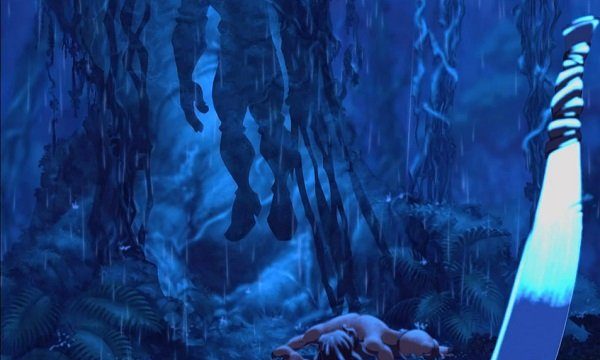I don’t know when the idea of Disney’s output being tame and over-sweet got started; it wouldn’t surprise me if it’s about as old as the studio. Certainly it’s something I’ve been hearing my whole life. In that time, I have seen—in the theatre—a villain hit by a train and knocked into a river, a child nudging his father’s body while believing he is responsible for said father’s death, and a man murdering what turns out to be a sentient being while seeking revenge for his brother’s death. Thereby, on that last one, orphaning what will turn out to be his sidekick for most of the picture. You know, for kids.
Sure, my reaction to the news that Disney was adapting The Hunchback of Notre Dame was as astonished as the next person’s, and it’s definitely true that they sanitized that ending. Likewise the ending of The Little Mermaid, which to be strictly fair doesn’t entirely make sense in the original story anyway. Happy endings? Yes, Disney does tend toward those. However, just as Pixar considers making you cry at the end of a movie to be the province of amateurs, Disney can scare the bejeezus out of a kid at just about any time, and not even the most sensitive of kids, either.
It’s true that kids can be traumatized by the weirdest things, something best immortalized in Pixar’s Inside Out, when we see Riley’s prison of fears. However, it doesn’t take a particularly weird kid to be afraid of some of what Disney’s presented over the years. Stephen King, who knows a thing or two about scaring people, points out that it doesn’t take much imagination on the part of a child to conflate puppies with children and find Cruella de Vil terrifying because of the imagery of a woman who wants to skin children for coats. I challenge you to find a stretch where Disney went more than three films without something that would scare the pants off their assumed target audience.
My own favourite aunt famously, in our family, cried in the theatre when watching Bambi (probably in the ‘47 rerelease, where she would’ve been about seven; two would’ve been a bit precocious for this story), “I don’t want Bambi’s mother to die!” Which set off the man behind her, who sniffed, “Damn kid!” At that, I’m not sure I would’ve been afraid at that moment at her age, necessarily. I find it at least as likely that I would’ve cried, since my own father (her brother) had died when I was six, and it would have triggered my grief as so much did at that point in my life. Disney’s scary, goodness knows, but fear isn’t the only emotion it provokes in children.
Someone out there is gearing up to point out the package films. Lots of kids are scared of Cernabog; I was scared of “Ave Maria,” myself. Fantasia was followed by Dumbo, with the pink elephants and the maternal separation and all that. (If you don’t weep at “Baby Mine,” you may well be dead.) Then we get Bambi, of course. I grant you there’s nothing much to be scared of or overly emotional about in Saludos Amigos or The Three Caballeros, though I could see a child’s being afraid during “Pedro” or “The Cold-Blooded Penguin.” But after that is Make Mine Music and “The Whale Who Wanted to Sing at the Met,” which could scare kids and which makes me cry. Fun and Fancy Free is relatively tame but does have Willy the Giant. Melody Time doesn’t have anything much, but it’s followed by The Adventures of Ichabod and Mr. Toad, and well then. And then we’re out of the package films.
Later, in the stretch after Walt died, you get The Aristocats, wherein kittens are left for dead by someone who’s supposed to protect them, which, again, a child can conflate with children pretty easily. Robin Hood suggests that Our Hero is dead, and as I recall, Prince John gets a moment where he’s utterly out of control, and that’s also kind of scary to a small child. I’ll give you The Many Adventures of Winnie the Pooh, but even if you yourself don’t find anything in The Rescuers scary, there’s a lot in The Fox and the Hound—the first Disney animated movie I saw in the theatre in its initial release—that could scare a child. And The Rescuers is many things, but it’s hard to beat for cruelty in the moment where Medusa casually asks why anyone would want a homely child like Penny—and Penny’s fear while she’s in that cave could be awfully contagious.
I’m not saying every Disney movie ever is full of that sort of moment. I don’t remember enough about the half of Chicken Little I’ve seen (yes, you could pay me on Patreon or Ko-fi to finish it) to remember if there’s anything with emotional weight in it; I suspect not. But we’ve barely even touched on the big names, here. Maleficent, who wants to kill a child in her cradle. All those evil stepmothers. Lucifer the cat in Cinderella chasing the mice we’ve befriended over the course of the film. And if I’d seen Tarzan in the theatre—for a lot of reasons, I did not—I would’ve started the list of horrific Disney things I saw in the theatre with a villain so wild for revenge that he actually hangs himself by cutting away his own supports. You know, for kids.


